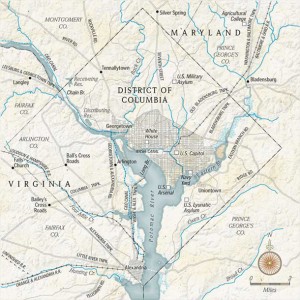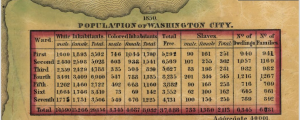Exhibit Topic
April 17, 2014
Main Topic
The main topic of the exhibit that I am creating on omeka.net is a narrative that details the change of the boundaries of the District of Columbia. Not only does it talk about the dates the changes were made, but it goes into detail about the reasons why the changes were made.
Content
The exhibit will include many maps throughout the history of D.C.’s existence and a narrative that details the history of the change in its boundaries. Here is an example of a map of Washington D.C.
It’s a map of the planning of the district. Through the use of maps and narratives fro each of the communities that used to be apart of the district, I hope to create an exhibit that clearly illustrates the change of D.C.’s boundaries while at the same time being as interesting as possible.
An Elaboration on Project Ideas
February 26, 2014
The one idea that I like the most from my last post is looking into the change of the size of Washington D.C. The history behind why the changes were made is what is interesting. Next steps would be to look at maps of D.C. throughout history and to look up the history of time around the times that the size changed. Looking for maps would be done at the library of congress website, and other research would have to be done through traditional web searches and searching through databases for primary sources from the times of change. Books would be another great source of information, and there are quite a lot of books on D.C., being that is the nation’s capital. Diving into this subject will be tricky but the plethora of information out there will definitely help.
Final Project Idea Proposal
February 19, 2014
First Idea
Something about the history of Washington D.C. that interests me is the change of the area that the district encompasses. The District of Columbia has changed in both size and shape throughout the years, and the reasons for the changes have serious historical implications. Exploring those implications and their impacts on the rest of history makes for an interesting project. Research would start with a Google search and looking at various maps of the district throughout time. In order to figure out why changes took place an understanding of the events that transpired during the time of the change. This topic is important because it chronicles the history that impacted the capital of the United States of America. Something that changed the literal shape of the district where the capital is located has to be quite a significant event. It could be a very interesting topic to research.
Second Idea
Another thing of interest for me would be to find out the extent of the district’s involvement in the civil war. With it being on the border of the enemy and where the Commander and Chief of the Union army residing within, there is bound to be plentiful significant events. There is also the possibility that D.C.’s involvement was minimal and the reasons behind that may be interesting as well. Finding the answer is important because it helps shape the whole story of the civil war and D.C. is not mentioned much in discussions about the civil war. Searching for sources would start at a database such as the library of congress. Primary sources would be a gold mine for this idea because they help shape the story in a way that secondary sources cannot. Primary sources, especially from the civil war, help express the emotion of the people involved which helps create a better understanding of what is being studied. There are also probably countless books on the civil war that mention the District of Columbia and the extent of its involvement.
Third Idea
The last topic that I could possibly explore is the change in residency, in terms of demographics, in different parts of the city over the course of its existence. I have already done some reading on this topic and it’s apparent that extensive research has been done to study this. The migration of people is indicative of the times and what was going on in the particular point in history. The importance is being able to establish what sort of impact the events of periods in time had on the people and how it affected their decision on where to live. Census data would obviously be a good place to start. Another place to start would be to research studies that have been conducted on this subject. An understanding of Washington’s history is crucial to being able to analyze shifts in population, so reading on history the district would be necessary. Something of particular that would need to be looked into would be the histories of certain neighborhoods.
Primary Sources
February 10, 2014
What is it?
The first primary source that I happened to stumble upon is a map of D.C. from the year, 1851. The map can be seen by clicking here. The major streets of D.C. are labeled, and so are the addresses of what appears to be pretty much every building in the capital at the time.
The second primary source is the agreement the United States made to pay France for the Louisiana Purchase. The digital copy of the document can be found here.
Analysis
The first primary source is indeed valuable in the right context. It brings in great insight to 1851 Washington, D.C.; with its illustrations of what were deemed important buildings in D.C. to the geographical location of the Potomac River. One can learn that D.C. has changed in the territory that it possesses. This becomes obvious when looking at a current map of D.C., the shape and the amount of land within its borders is distinctly different than 1851 D.C. Something to take note of is the White House is referred to as the “President’s House”. The map even features a census of D.C. (shown below) that is broken down by ward, white population, colored population, and slave population.
When it comes to actual historical facts about Washington D.C., other than population facts, the map obviously falls short. There is only so much that a person can draw from a map, but that is not saying that a map is scarce of information because that is just not that case.
The second primary source is a great example of why everything should not be digitized. The digital version of the document seems to make the difficulty of reading the old document immensely harder. The document is illegible, making the source pretty much unusable. In this case, a translation to a new, online, document would be exponentially more useful than the original document in digitized form. It is very difficult to think of any positive ways to use this source. The only reason I believe there is one is because someone must have thought so because they took the time to upload it to the internet. Nonetheless, the reason escapes me and my ultimate judgement is that this digital primary source is useless.
A Review of Two Websites
February 2, 2014
The two websites that will be reviewed in this blog post are Slavery and the Making of America and The Primeline Midi Library. Even though they both are of a historical theme they cover very different topics, the first deals obviously with slavery in America and the other deals with historical music.
Purpose of the Website
Slavery and the Making of America is authored by PBS and serves as a website that presents information that coincides with the idea that slave labor shaped America into what it is today. There is a ton of different information ranging from everyday life of the slaves to “did you know?” facts. There are even prime sources in the form of recorded stories from former slaves. The website features loads of information that can be used for an academic purpose or just to broaden one’s knowledge of slave life in America.
 (photo from http://www.pbs.org/wnet/slavery/index.html)
(photo from http://www.pbs.org/wnet/slavery/index.html)
The Primeline Midi Library is quite different from the Slavery and the Making of America website due to the fact that there isn’t much information, but it serves as an archive of historical music, mainly classical and ragtime. The selection is not exactly vast, but its lack of vastness is expected when venturing onto the site, so it isn’t such a let down.
Credibility
Both websites appear to be very credible; Slavery and the Making of America is obviously credible because it was created by PBS, and The Primeline Midi Library does indeed have the music that it claims to have. so, there is no need to fear being deceived when venturing on these websites.
Aesthetic Appeal
Slavery and the Making of America is simply organized in the best of ways. The colors of the website are very earthy and go beautifully with the content of the website. The website is very easy to navigate making learning and obtaining information very easy for the user.
The Primeline Midi Library may be one of the ugliest websites on the internet. It looks like it was made in the early 1990’s, but it is easy to navigate thanks to the navigation tool bar at the top of the homepage.
Overall Thoughts
Overall both websites serve their purposes very well and can be taken advantage of by the academic or regular user of the internet that may be interested in the content of the websites.
First Blog Post
January 26, 2014
Hello internet,
My name is Brady Jenkins and I am a sophomore at George Mason University. I am an avid sports fan and I support only DC teams with the exception of the Baltimore Orioles. Needless to say I know what it is like to constantly be disappointed by the teams that I love so much. I don’t have a very big presence online; I have several accounts on different social medias but I seldom use them. I am on facebook, Twitter, and instagram. I mainly use the internet to read about the news, stay up to date on the world of sports, and to play fantasy football. I’m not quite sure what else to talk about, so I am going to complain about the cold weather. I hate cold weather, and I especially hate walking to class with ice everywhere. If I had a dollar for each time I almost fell on my butt around campus I’d be able to pay off my loans. And having to where eighty layers of clothes isn’t particularly fun either. i can’t wait for winter to be over; it’s easily the worst season. If you read this I thank you for taking the time to do so.
Hello world!
January 26, 2014
Welcome to onMason. This is your first post. Edit or delete it, then start blogging!



